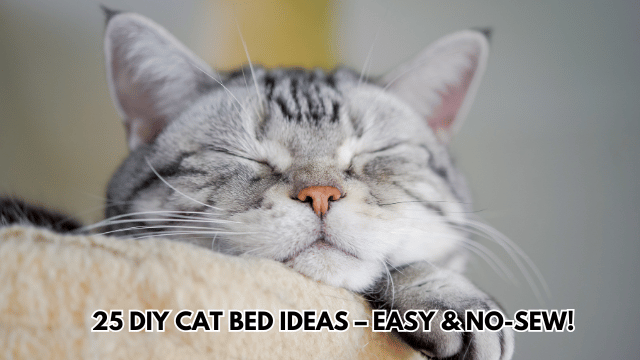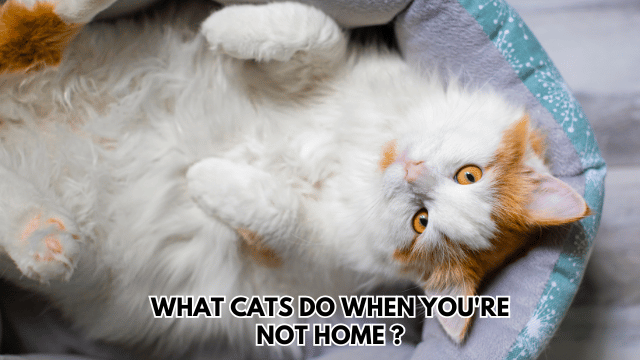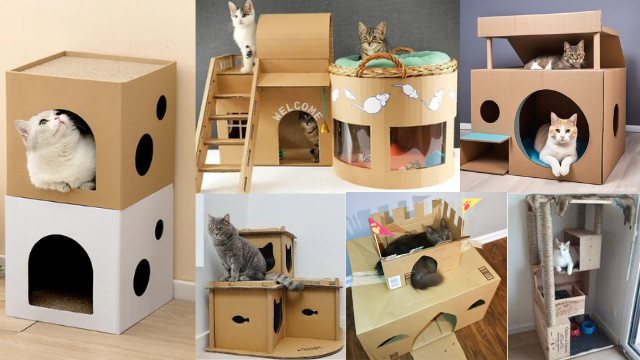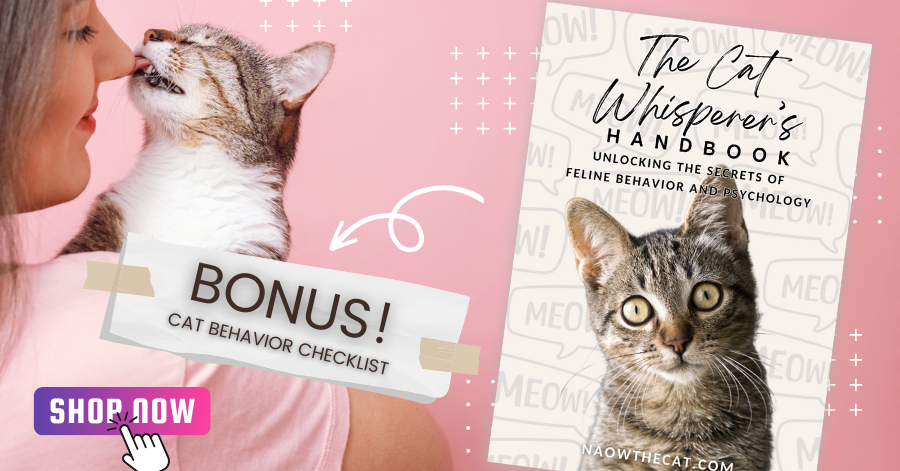“If I fits, I sits.” — Every cat, ever 😹 It’s no secret that cats are obsessed with cardboard boxes. Whether it’s a shipping box, a cereal box, or a shoebox, your feline friend will likely claim it as their new throne. But why stop at plain boxes when you can create a cozy, customized cardboard cat house ?
Why Make a DIY Cardboard Cat House ?
Tips: Material, Design, Decoration & Safety
🌟Bonus Tip🌟
- The Classic Cozy Cabin
- The Multi-Level Mansion
- The Window Watchtower
- The Tunnel of Fun
- The Artistic Abode
- The Scratch Pad Palace
- The Hideaway Hut
- The Adventure Fort
- The Convertible Condo
- The Seasonal Sanctuary
- The Interactive Igloo
- The Zen Den
Why Make a DIY Cardboard Cat House ?
1. Cats Love Cardboard
According to experts at PetMD, cats are naturally drawn to cardboard because it provides warmth, texture, and a sense of security. It’s like a cozy little fort that smells interesting and feels safe. Why fight nature?
2. Affordable and Budget-Friendly
Let’s be real—cat furniture can be expensive. A cardboard cat house costs next to nothing if you’re recycling boxes you already have. No fancy tools or high-end materials required.
3. Eco-Friendly Choice
Instead of tossing old boxes in the trash, reuse them! You’re reducing waste and giving cardboard a second life. According to the ASPCA, sustainable pet ownership is a growing trend, and this fits right in.
4. Fun DIY Project
Crafting your cat’s new hideaway can be a fun weekend project. You don’t need to be a pro crafter—just some scissors, tape, and creativity will do. It’s also a great way to get kids involved and teach them about caring for animals.
5. Customizable for Your Cat’s Personality
Is your cat a king? Make a castle. A sleepy explorer? Try a safari hut. A grumpy old soul? A minimal box with a privacy flap might be their jam. You can tailor it completely to your cat’s quirks.

6. Keeps Cats Entertained
Bored cats can get destructive. A cardboard house with multiple levels or peek holes can serve as a playground, helping them stay active and mentally stimulated.
7. Easy to Replace
Cats are tough on their furniture. When a cardboard house gets scratched up or worn out, you can toss it in the recycling bin and whip up a new one with minimal effort and cost.
8. Safe and Non-Toxic
When made right, cardboard houses are safe. Use pet-safe glue and avoid any sharp objects or choking hazards. Most cats won’t try to chew or eat cardboard, but supervision at first is always smart.
9. Great for Small Spaces
Live in a small apartment? No problem. DIY cardboard houses can be compact and stackable. You can design one that fits perfectly on a shelf, under a table, or in a corner.
10. Reduces Stress for Shy Cats
According to the Humane Society, having a quiet place to hide can help reduce anxiety in cats, especially new rescues or shy kittens. A cardboard house becomes their little escape room when things get too loud or overwhelming.
11. Portable and Lightweight
Need to move the cat house from the living room to the bedroom? Easy. Cardboard is super light and flexible, making it ideal for rearranging without any hassle.
12. Lets You Bond with Your Cat
Cats may not say thank you—but they’ll show it by using and enjoying the house you built. It’s satisfying to see them happily napping or playing inside something you made just for them.
13. Encourages Enrichment and Play
Adding toys, tunnels, or scratchable surfaces inside the house turns it into an enriching environment. According to Jackson Galaxy (yes, the famous cat behaviorist), environmental enrichment is key to a happy cat.
14. You Control the Aesthetic
Want something cute? Elegant? Goofy? You’re the designer. Unlike store-bought furniture, your DIY project can match your personal style or seasonal décor (Halloween haunted house, anyone?).
15. Great Backup Option
Even if you already have a fancy cat tree or bed, a cardboard house serves as a great backup or secondary nap zone. Some cats even prefer cardboard over plush.
In short, a DIY cardboard cat house is cheap, simple, and super rewarding—for both you and your cat. And hey, when your cat loves the box more than the toy it came in, why not just give them the box? 😼

Tips for Making a Cardboard Cat House
Creating a cardboard house for your cat might sound simple—and it is—but there are a few tips that can take your project from “meh” to “meowgical.” Here’s what to know before you grab that box cutter:
1. Choosing the Right Cardboard
Not all cardboard is created equal. Here’s what to look for:
- Go thick and sturdy: Use corrugated cardboard. The thicker, the better—it holds up to cat claws and movement.
- Avoid boxes with strong odors: Don’t use boxes that held chemicals, cleaning products, or food with lingering smells.
- Check for water damage: Damp cardboard is weak and prone to mold. Always use dry, clean materials.
🧡 Tip: Appliance boxes or shipping boxes from online orders often work great!
2. Planning the Cat House Design
Before you start cutting:
- Sketch your idea: It doesn’t need to be fancy, just get your basic structure and measurements down.
- Think like a cat: Include cozy corners, high perches, and peek-out holes.
- Keep it simple at first: If it’s your first DIY cat house, start with one level and a simple box with an entrance and a window.
🎯 Pro tip: According to The Humane Society, cats love hiding spots, so always include at least one covered area or enclosed section.
3. Building a Strong Base
Your base needs to hold your cat’s weight and movements.
- Use double layers of cardboard: This prevents the base from collapsing over time.
- Glue or tape securely: Use hot glue, strong packing tape, or non-toxic wood glue to keep pieces in place.
- Add internal support: Use cardboard strips vertically inside corners to reinforce the walls and roof.
💡 Bonus: Add a small rug, fleece, or cushion on the base for extra comfort.
4. Adding Levels and Tunnels
Want to level up (literally)? Here’s how:
- Stack boxes: Cut holes between levels for your cat to climb through. Tape or glue them tightly so they don’t slide.
- Use ramps or stairs: Make climbing easy for kittens or older cats by cutting slanted pieces of cardboard as ramps.
- Add lookout points: Cats love high places. Give them a rooftop perch to spy on their kingdom (aka your living room).
📚 Fun fact: According to International Cat Care, vertical spaces help reduce stress in multi-cat homes by giving cats room to escape and observe.
5. Decorating the Cat House
This is where you can have fun!
- Use non-toxic materials: Only paint or decorate with cat-safe, water-based products.
- Get crafty with paper: Use paper scraps, construction paper, or fabric to add character.
- Add your cat’s name: Personal touches like a custom nameplate or cute doodles make it special.
- Go seasonal: Create themed houses for Halloween, Christmas, or even your cat’s birthday!
🛑 Warning: Avoid glitter, tiny glued-on objects, or anything your cat might chew and swallow.
6. Safety First
Your cat’s safety is always priority number one.
- Smooth the edges: Sand or tape over sharp edges and corners.
- Avoid choking hazards: Don’t add small parts like beads, googly eyes, or buttons.
- Check adhesives: Use hot glue or non-toxic glue. Avoid super glue or anything with fumes.
- Monitor use: Especially during the first few days—make sure your cat isn’t trying to eat cardboard or decorations.
🐾 Expert Insight: According to PetMD, cats can suffer from “pica” (eating non-food items). If your cat tries to chew up and swallow the house, it may not be the right project for them.
7. Maintaining the Cat House
Even the fanciest cardboard castle will wear out eventually. Here’s how to keep it in top shape:
- Vacuum or shake out fur and litter: Do this weekly to keep it clean.
- Check for wear and tear: Look for loose edges, sharp cardboard, or collapsed areas.
- Replace as needed: Most cardboard houses last a few months, depending on your cat’s activity level.
🌿 Pro tip: Sprinkle a bit of catnip or silvervine inside to keep your cat interested as the novelty fades.
12 DIY Cardboard Cat House Ideas

1. The Classic Cozy Cabin
Start with a sturdy cardboard box large enough for your cat to move around comfortably. Cut out a door and a few windows for ventilation and curiosity peeks. Decorate the exterior with non-toxic paint or wrapping paper to match your home decor. Add a soft blanket or cushion inside for extra comfort.
2. The Multi-Level Mansion
Stack multiple boxes of varying sizes to create a multi-level cat house. Cut holes between the boxes to allow your cat to climb from one level to another. Secure the boxes together with hot glue or strong tape. This design provides both a resting area and a play zone for your cat.
3. The Window Watchtower
Cats love to observe their surroundings. Create a tall, narrow cardboard structure with a platform at the top. Cut out windows at different heights so your cat can peek out. Place the tower near a window to give your cat a perfect vantage point.
4. The Tunnel of Fun
Connect several cardboard tubes or long boxes to form a tunnel system. Cut entrances and exits at various points to create an engaging maze. This setup encourages your cat to explore and play, providing both physical and mental stimulation
5. The Artistic Abode
Get creative with your design by crafting a cat house that resembles a famous landmark or building. Whether it’s a mini version of the Eiffel Tower or a cozy cottage, the possibilities are endless. Use safe materials and ensure all parts are securely attached

6. The Scratch Pad Palace
Incorporate scratching surfaces into your cat house by lining the walls or floors with corrugated cardboard or sisal rope. This design not only provides a cozy space but also helps keep your cat’s claws healthy and your furniture safe
7. The Hideaway Hut
For cats that prefer solitude, create a simple, enclosed box with a single entrance. Line the interior with soft materials and place it in a quiet corner of your home. This hideaway offers a peaceful retreat for your cat to relax undisturbed.
8. The Adventure Fort
Design a complex structure with multiple rooms, levels, and passageways. Incorporate toys, hanging elements, and different textures to keep your cat engaged. This elaborate setup can provide hours of entertainment and exploration.
9. The Convertible Condo
Create a modular cat house with detachable sections. This design allows you to rearrange or expand the structure as needed. It’s perfect for accommodating multiple cats or adapting to your cat’s changing preferences.
10. The Seasonal Sanctuary
Customize your cat house to reflect different seasons or holidays. Add themed decorations, colors, and accessories to keep things fresh and exciting for your cat. Just ensure all additions are safe and non-toxic.
11. The Interactive Igloo
Design a dome-shaped structure with interactive elements like hanging toys or treat dispensers. This engaging environment stimulates your cat’s senses and encourages play.
12. The Zen Den
Incorporate calming colors, soft lighting (like LED candles), and soothing textures to create a relaxing environment for your cat. This peaceful retreat can help reduce stress and anxiety.
Bonus Tip
To enhance your cat’s experience, place the cardboard house in a location where your cat feels safe and comfortable. Avoid areas with heavy foot traffic or loud noises. Regularly clean and inspect the house for wear and tear, replacing parts as needed to maintain a safe environment.

Creating a DIY cardboard cat house is a rewarding project that benefits both you and your feline friend. Not only does it provide a cozy space for your cat, but it also allows you to express creativity and recycle materials.
Remember, the goal isn’t perfection. Your cat doesn’t care if the lines are straight or the paint’s a little smudged. What they do care about is comfort, hiding spots, and fun. Keep it safe, cozy, and suited to your cat’s personality—and you’re golden. So grab those boxes and start building your cat’s dream home today! 😻
Watch Videos about Cat & Kitten Care on Youtube @naowthecat